PowerTap PowerCal In-Depth Review
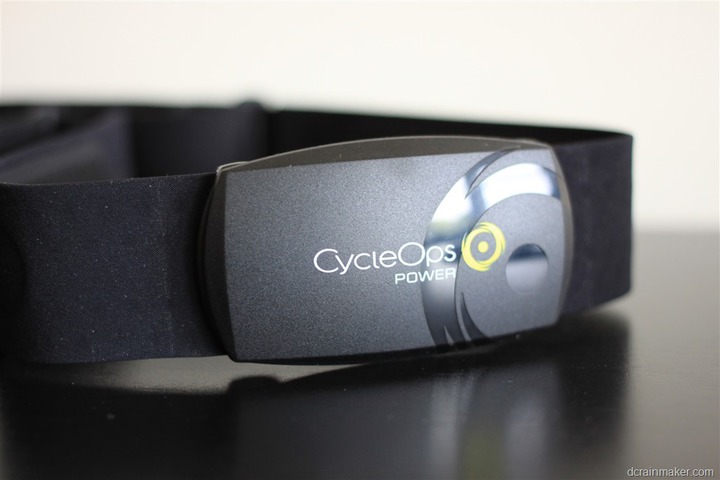
A bit over a year ago CycleOps announced their latest devices – and with it their first power meter that wasn’t in a rear wheel hub . CycleOps has a long history of power meter head units (and power meters), an area they’ve been at the forefront of for years. When the product was announced, many within the industry were skeptical on how accurate a power meter could be based purely on heart rate data. And further, for as low of a price as it was being offered (now down to $99). So, I’ve dug in to find out and separate fact from fiction from FUD.
Like all my reviews, they tend to be pretty in depth (perhaps overly so) – but that’s just my trademark DC Rainmaker way of doing things. Think of them more like reference guides than quick and easy summaries. I try and cover every conceivable thing you might do with the device and then poke at it a bit more. My goal is to leave no stone unturned – both the good and the bad.
While during the initial development period, I picked up a unit from CycleOps at Interbike that year (anyone could for free). I have since procured my own final unit, which is what this review is based on. If you find my review useful, you can use any of the Amazon or Clever Training links from this page to help support future reviews.
Lastly, at the end of the day keep in mind I’m just like any other regular triathlete out there. I write these reviews because I’m inherently a curious person with a technology background (my day job), and thus I try and be as complete as I can. But, if I’ve missed something or if you spot something that doesn’t quite jive – just let me know and I’ll be happy to get it all sorted out. Also, because the technology world constantly changes, I try and go back and update these reviews as new features and functionality are added – or if bugs are fixed.
Unboxing:
First up is the exterior box. Note that there are a few variants of the PowerCal unit floating out there. One includes just the PowerCal strap (combo heart rate and power). Another includes the strap + an ANT+ speed sensor. And the third includes a strap + speed sensor + calibration stick (ANT+ stick).
If you already have a Garmin Forerunner with an ANT+ stick, there’s no need to buy that stick package. They all work just fine with each other interchangeably. Same goes for the speed sensor. In fact, I see little reason to buy anything other than the $99 package (just the strap).
That said, this particular unboxing includes the extra pieces.
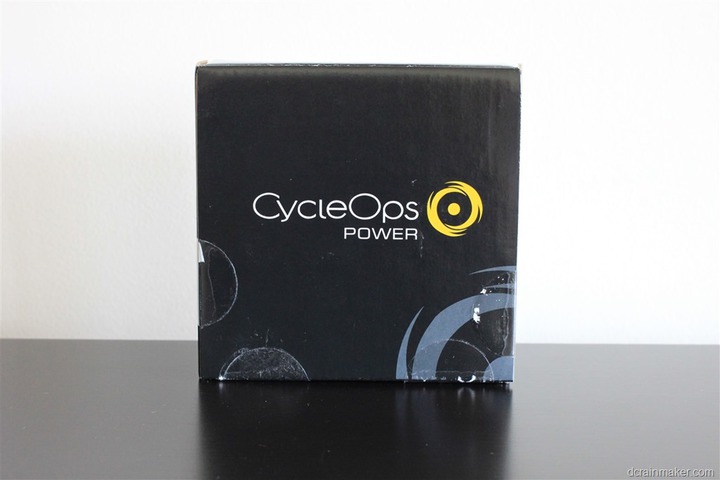
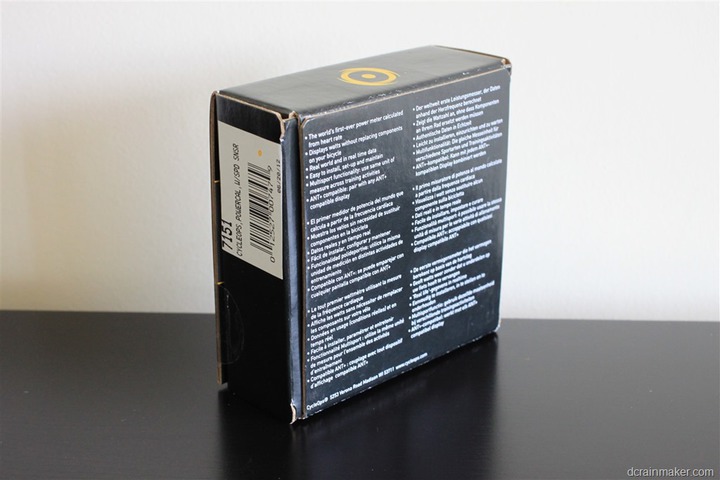
Cracking the box open, you’ll see the heart rate strap transmitter pod looking up at you.
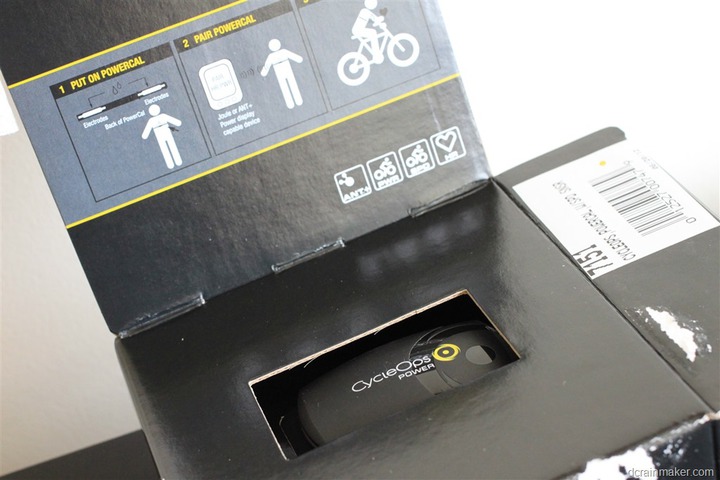
After taking the top off the box, we’ve got the following little baggies full of goodness.
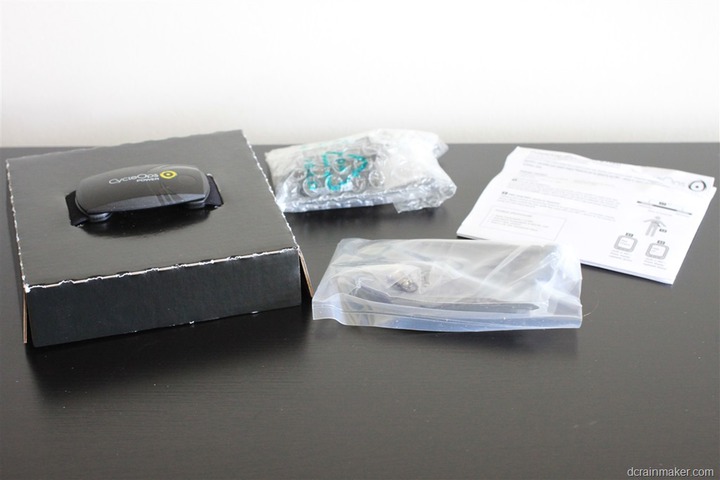
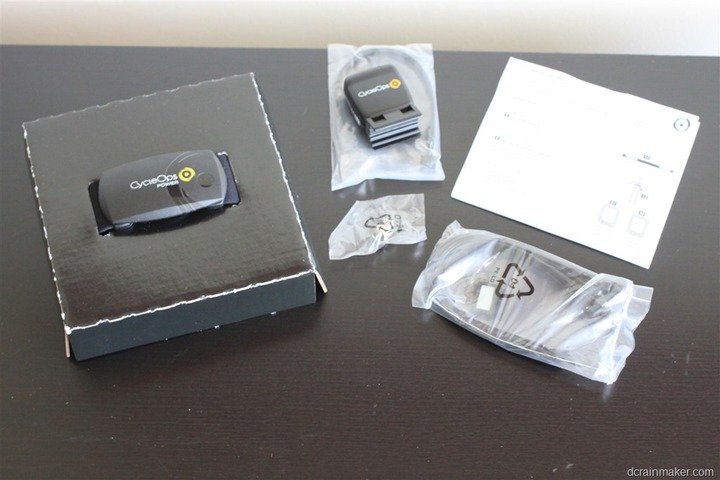
Those bags include the PowerCal strap (left), the speed sensor (upper middle), the slew of zip ties for the speed sensor (bottom middle), and the manual that you won’t read (right).
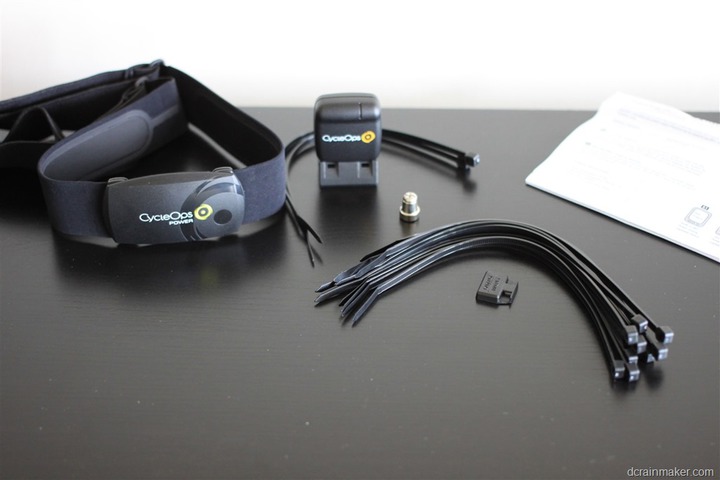
First up – the PowerCal strap and the speed sensor. Note that this isn’t a combo speed/cadence sensor, but rather just a speed-only sensor. Also note that not all ANT+ capable units support the speed-only sensor. Virtually every ANT+ unit out there supports the speed-cadence combo sensor, but less just the speed-only.
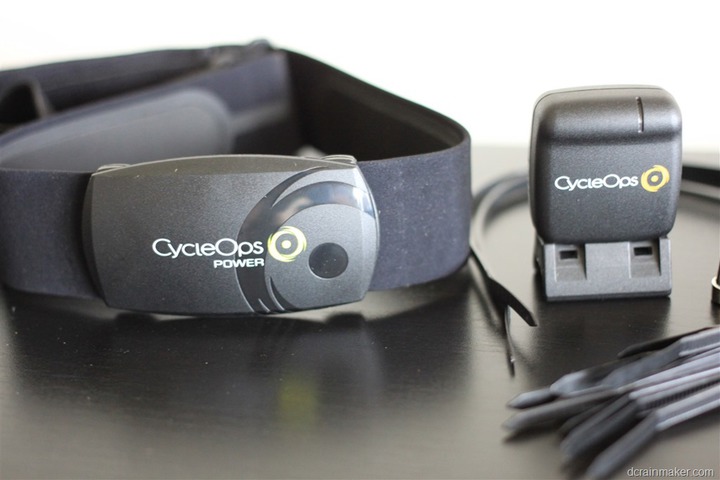
Here’s the manual. We can pretend you’ll read it.
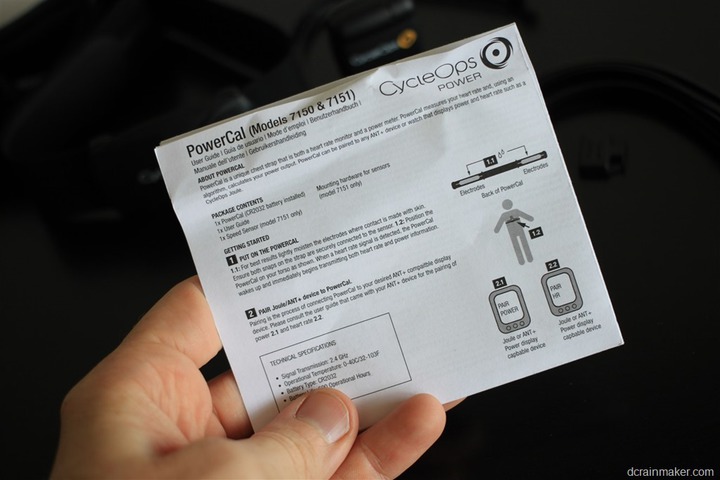
Back to the speed sensor – you’ve got the transmitter unit, and the small spoke magnet sticking up there. You attach that to a spoke on your rear wheel, and the transmitter to your bike frame using the plethora of zip ties.
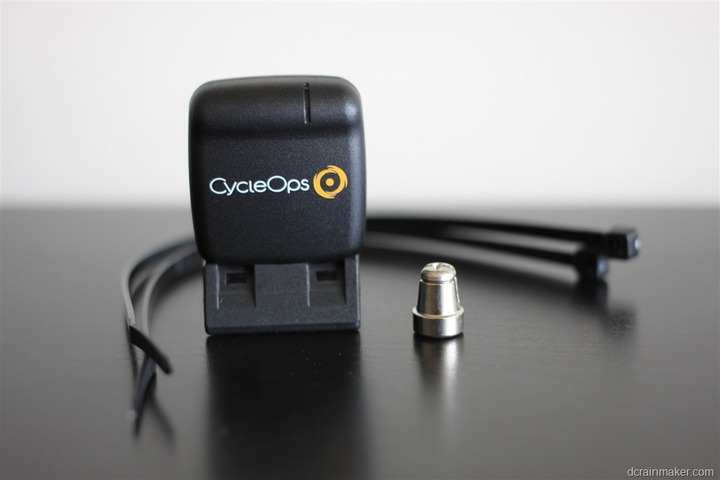
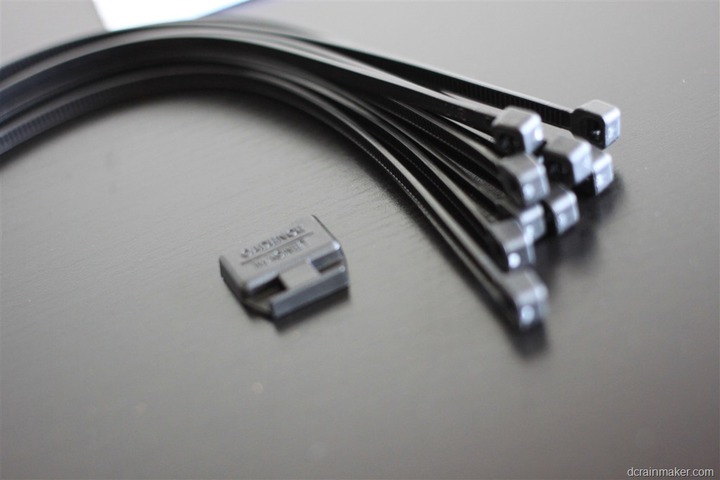
Here’s a bit better look at the heart rate strap itself. In many ways, it looks just like any other ANT+ heart rate strap out there.
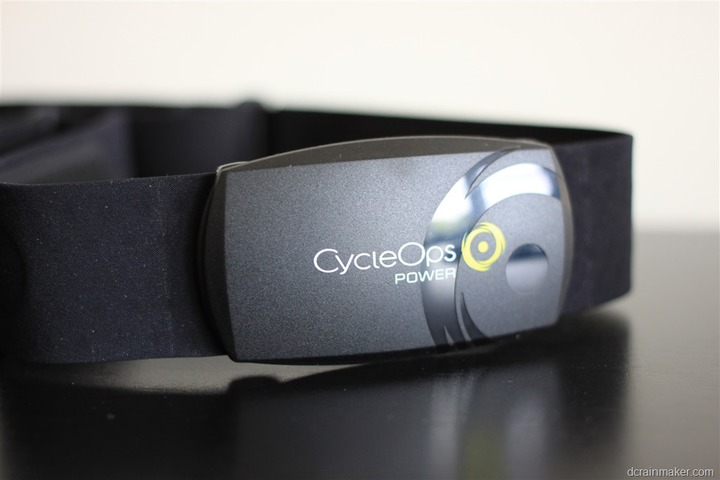
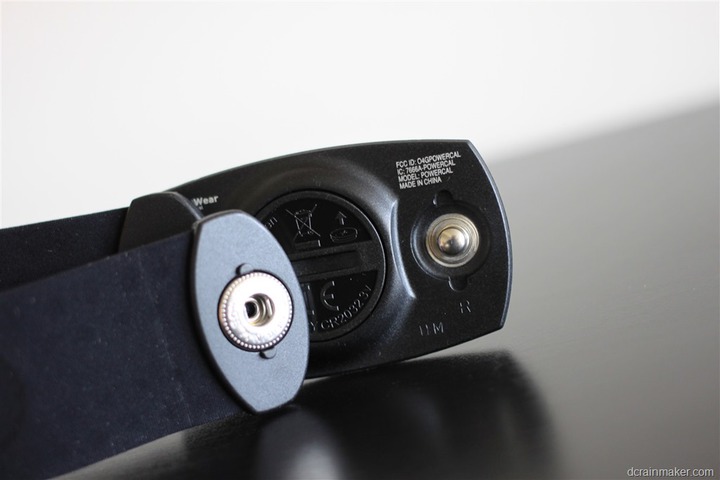
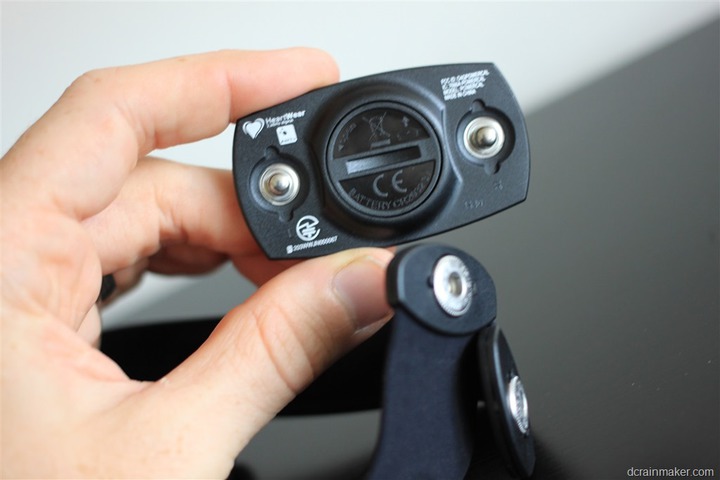
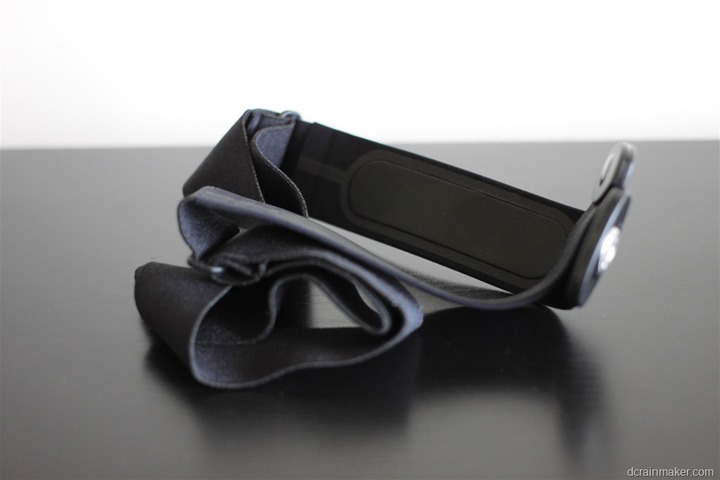
Ok, with the unboxing complete, it’s time to dig into the details.
Detailed Breakdown of PowerCal functional areas:
I’ve taken a bit of a different approach this time with the review. Not substantially, but probably just enough to be noticeable to regular review readers here. Given the PowerCal is essentially just a heart rate strap that also spits out a power number, I wanted to focus on the different scenarios, edge cases and functional areas of the strap. I started off with section numbers in my review draft, but realized it actually made it kinda easy to walk through starting with the simple, and then getting to more complex scenarios. Think of it like a school lesson book upon each previous chapter.
1) Setup, Installation, and Pairing with other head units:
Setup of the PowerCal is amongst the simplest device you’ll have to setup out there. In fact, it’s not really any different than that of a heart rate strap.
And while it used to be that in the earlier pre-production PowerCals required that you calibrated them, that’s no longer the case. After a 3rd party (Colorado University at Boulder) conducted a study on the accuracy of the units they found that there were no accuracy advantages in most cases by calibrating the unit (done via mini-FTP test). The only thing it served to do was add more complexity and and more test workouts to users that otherwise might not ever wish to complete them. But I’ll dive into this more later on.
With us ready to start pairing, you’re going to be pairing it twice. Once for the heart rate strap, and then once for the power meter. Some head units (like the Joule GPS) support a ‘find everything nearby’ function – but that’s about the only one that does (a cool feature). Hence why most other units you’ll have to do the two-step tango.
First, we’ll take care of the power meter piece. This will vary based on your exact bike computer, but you’re ultimately looking for the section that allows you to setup bike profiles/details and then pair the ANT+ power meter:
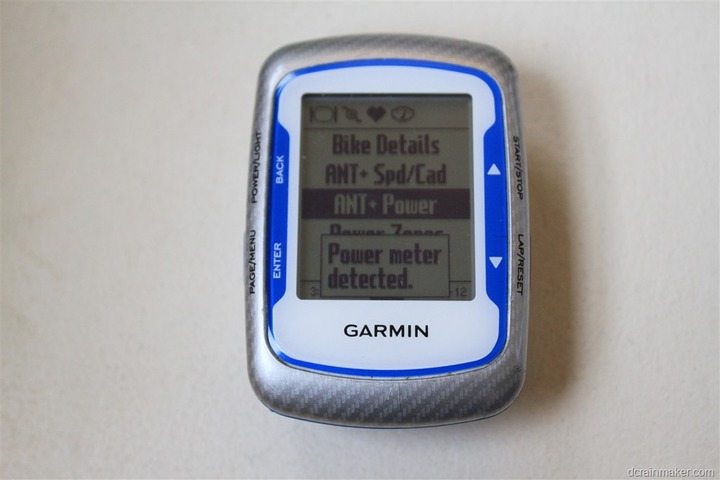
Once that’s done, you’ll usually see a device ID of some sort, and a message saying either connected or paired.
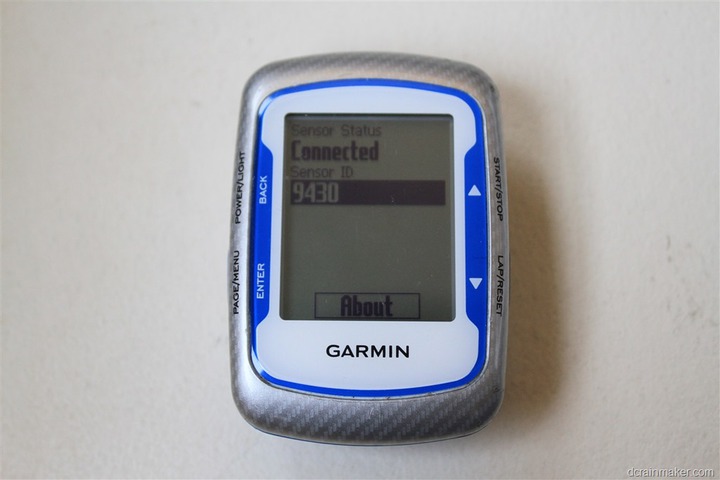
In some models, you can even get additional information about the unit as well. Though not all bike computers have this.
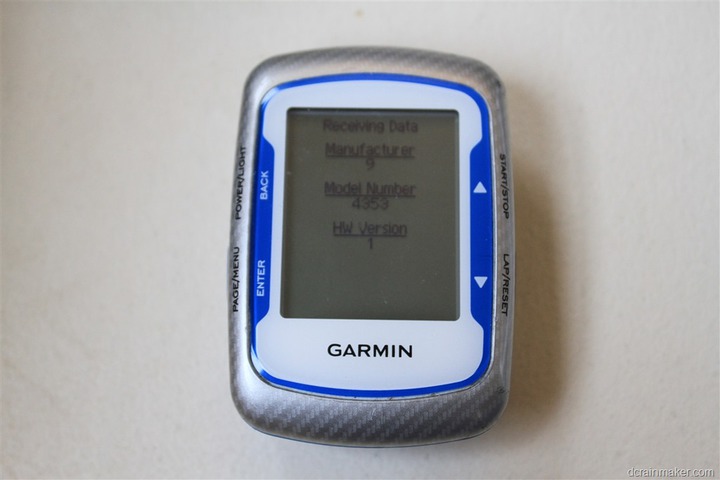
Once your power meter is found, you’ll want to complete the same steps for the heart rate side as well. Usually the heart rate settings are found in one of two places. Either the person/user settings, or the bike sensor settings. It depends on the model. Ultimately though, you’re looking for something that says “Heart Rate Sensor” or “Heart Rate Strap”
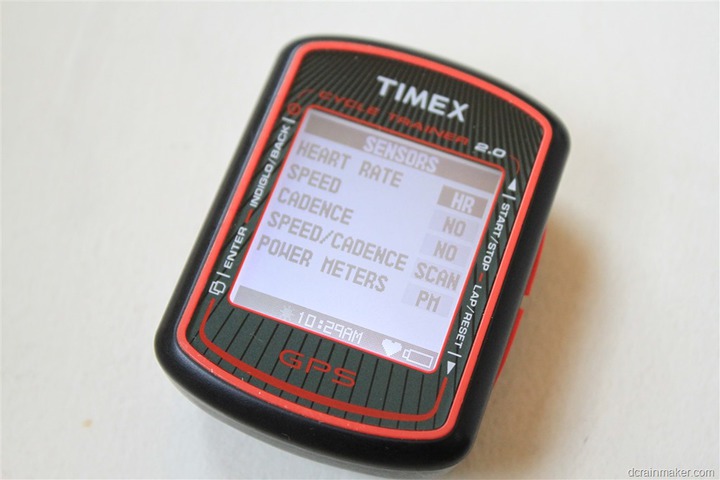
Finally, a fun little note – if you attempt to calibrate the PowerCal using the automatic calibration button found in most bike computers, it will not succeed. The calibration button found there is designed for direct force power meters, and not for PowerCal.
The PowerCal calibration function is very different, and I talk about that much later in this post.
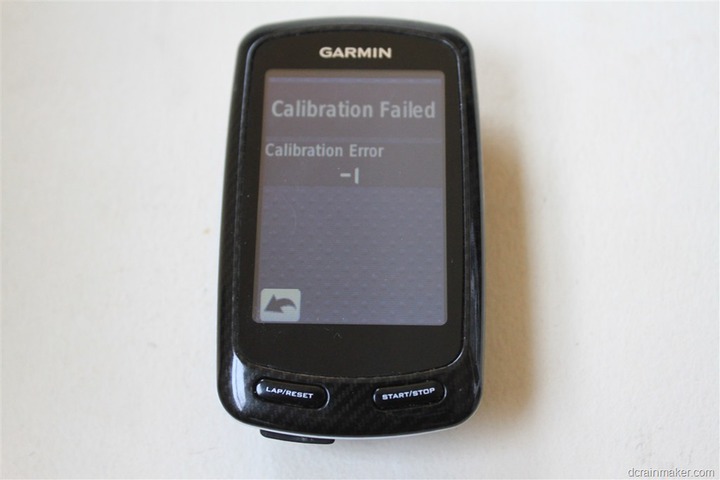
2) Looks like a normal power meter on units
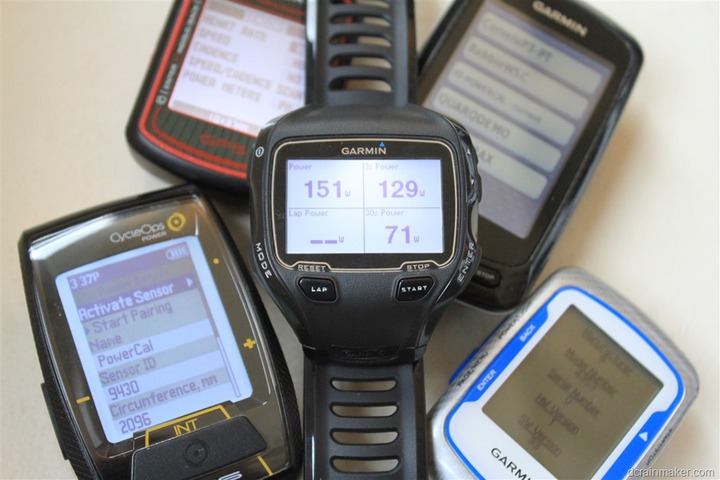
The most important thing about the PowerCal is that it looks like a normal ANT+ power meter. As you saw in the previous section – it’ll pair like any other power meter does to any other power-meter capable head unit.
These include (not a complete list, just off the top of my head), the following units:
4iiii’s Heads Up Display
CycleOps Joule 2.0 & 3.0
CycleOps Joule GPS
Garmin Edge 500
Garmin Edge 705
Garmin Edge 800
Garmin Forerunner 310XT
Garmin Forerunner 910XT
Magellan Switch
Magellan Switch Up
Motorola Motoactv
Timex Global Trainer
Timex Cycle Trainer GPS
Various iPhone apps with Wahoo Fitness ANT+ adapter/case
Various Android apps with compatible phones (ANT+ chip on certain models, like Xperia Active)
With all of these units, comes the standard ANT+ power meter metrics that are typically available, these include the below – all of which work with the PowerCal:
Power (instant)
Power – Max
Power – Average
Additionally, any other data field offered on certain manufacture products that are dependent on the standard ANT+ data stream will work with the PowerCal, for example, these data fields:
Power (3-second)
Power (10-second)
Power (30-second)
Training Stress Score (TSS)
Intensity Factor (IF)
NP (Normalized Power)
Power Zones
% of FTP
Again, each of the above fields vary by head unit company – and not by the PowerCal itself. It’s merely transmitting the wattage that these different fields rely on. And of course, different companies can choose to implement the same fields slightly different ways – though most are fairly standardized.
3) Fluctuations in Power:
The single biggest difference you’ll notice between power numbers displayed by a PowerCal compared to most other power meters on the market is the fluctuation in instant power displayed on head units. In other words, the consistency (or lack thereof) of the power numbers.
Now, it should be noted that virtually all power meters display some sort of second to second variation that often concerns folks new to power meters. For example, a typical power meter will look like the below string (consider each number the following second). This is from a PowerTap hub across 13 seconds.:
114,117,117,118,104,130,116,120,108,106,106,119,108
Now, let’s take a look at some numbers from a PowerCal (these are aligned to the same 13 seconds as the PowerTap above)
35,68,130,163,225,258,260,230,200,105,75,0,0
What you see here is far greater variation between each second, as well as far more ‘super-high’ and ‘super-low’ numbers. For example, the 0’s and the 35/68.
Now, when looking at averages (and I just picked 13 random seconds), we see the following:
PowerCal: 135w
PowerTap: 114w
I won’t get into averages in this particular section, but you can see that while their methods are different, the overall averages are in the same ballpark (though, not the same base path).
To illustrate this a bit better, I’ve made the following video – which I’ve placed two power meter display units next to each other. The left unit (bigger Edge 800) is displaying power from the PowerTap, whereas the right unit (smaller Forerunner 910XT) is displaying power from the PowerCal. Both units are configured and setup identically, and both started at the same time.
Data displayed on Edge 800 (top to bottom): Instant Power, Power 3-second avg, Power 30-second avg, Lap Power
Data displayed on FR910XT: Instant Power (upper left), 3-second power (upper right), lap power (lower left), 30-second power (lower right).
What you’re looking at is how different the 3s (3-second) and 30s (30-second) power is between the two, and which one is most useful for pacing.
Video of instant-power
I’ve also placed the lap average on there as well, to allow you to get a sense for how the overall average of those units are comparing. Note that overall the units remain fairly stable, and fairly close.
4) Power Analysis After the fact – what the data looks like:
Before we get into some of the power files, I wanted to briefly cover what data looks like from the PowerCal, compared to regular direct force power meters.
At first glance, with some form of smoothing on – you may not notice much of a difference. It looks mostly like normal power meter data:
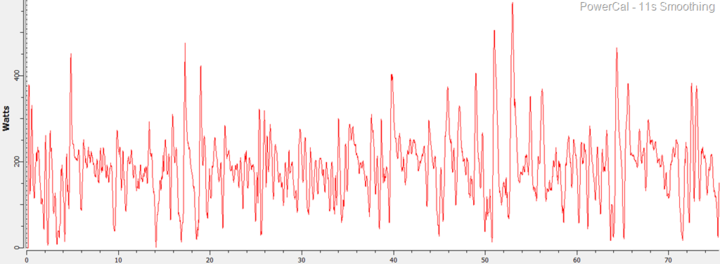
But as you remove the data smoothing you start to see just how jumpy the data is:
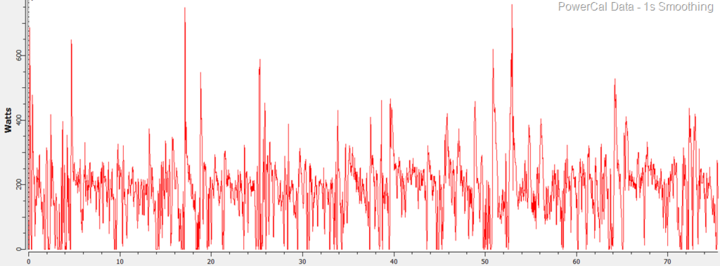
Compare a PowerCal and PowerTap on the same ride – and note how different the graphs look. Power meter data is always jumpy in general, but the degree that the PowerCal is jumpy is the interesting tidbit.
In the PowerCal (above), you’ll see that the data doesn’t hit the floor (bottom, zero-value) nearly as much as the PowerTap. This is because the PowerTap is instantly picking up when I stop applying force. So if I pause pedaling for just one second, it’ll capture that. Whereas the PowerCal takes a longer reaction time as it is based on heart rate.
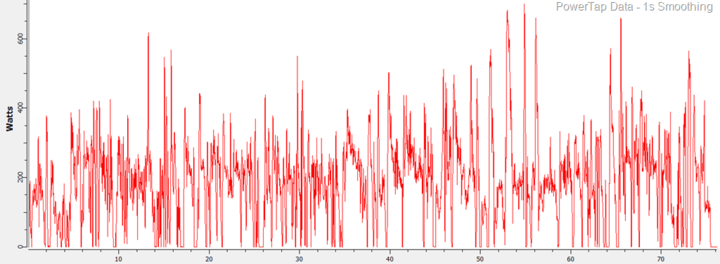
This is even more visible when you look at raw numbers in something like Excel. Below, a few columns of numbers – one on a PowerCal, another a PowerTap, and a third, a Power2Max. Ignore the correlation between them (well, you can look if you want) – instead, note the line after line differences (going from top to bottom). The change is far more significant between each value on the PowerCal than the PowerTap.
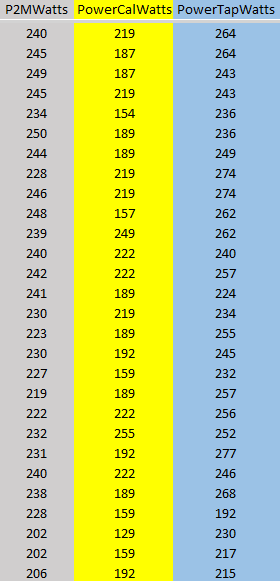
We’ll get into what this means in a bit.
5) Short duration power accuracy (sprints/intervals)
One of the most common questions with the PowerCal is how it handles short intervals from a power measurement and responsiveness standpoint. The reason being that since PowerCal is based on heart rate data, heart rate data will lag slightly behind power output.
For example, if you’re just calmly riding along at an easy wattage, and then burst into a all out sprint – it may take 5-20 seconds for your heart rate to show the impact of that – meanwhile, your wattage on a direct force power meter (normal power meter) would have shown that immediately.
In the case of PowerCal, I did some tests comparing lap averages over different lap durations. I went out on a closed course and simply held sustained efforts for each length of time. These weren’t set to me holding any given specific wattage, rather, me just holding a heart rate value that seemed interesting. Effectively, these were intervals. Though, the exact heart rate zone isn’t terribly important. What’s important first is how accurate the PowerCal can be during shorter durations (because your intervals will vary just like mine).
Here’s the results (click to expand):
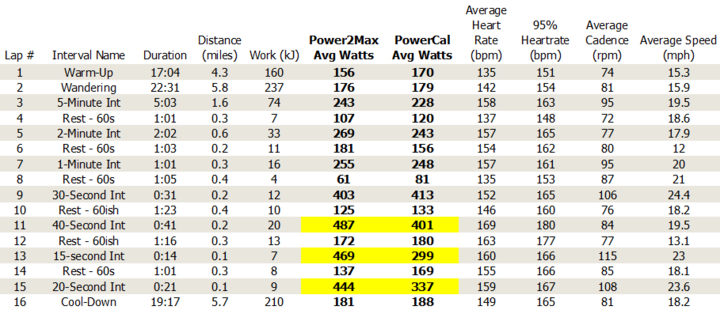
As you can see, the PowerCal seems to get relatively close down until about 30-40 seconds. At which point, the rate of change exceeds the PowerCal’s ability to measure the sprint. It did somewhat find on a 30-second attempt (#9), but had more problems in the 40-second one just after that. Above those times however, things were actually pretty close most of the time.
6) Full workout power accuracy (longer duration)
Now that we’ve covered the shorter sprint scenarios – how well does it hold up over the course of a workout?
Well, surprisingly well.
And that makes sense. At $99 the unit primarily targeted towards those interested in full-scope workout averages. Meaning, less focus on detailed lap by lap and interval analysis down to the watt.
In fact, this generally seems to align with most of the anecdotal data I’ve seen across many different cycling related forums. There are some outliers, yes, but most folks are pleasantly surprised at how well total averages perform. For fun, I pulled my four most recent rides:

Of course, total averages don’t tell the full story. And, many ardent power meter supports like to point out that total averages are useless – since they don’t show you important values like max efforts and what went into that. As noted earlier, you can arrive at a total average number many different ways. It’s how you arrived at that number that makes up a training session. Hence why other values besides averages are so important.
That said – for most individuals looking at buying the PowerCal, they are likely using simple speed today (MPH/KPH). Any cyclist will tell you that like other metrics – simple speed is just as dependent on wind, terrain, environmental factors like snow or rain, or even ones ability to navigate trail or road traffic.
Thus, in many ways the PowerCal isn’t much different here. But it does provide a overall wattage value to work with. Something that a simple speedometer doesn’t. Different folks will be able to interpret that differently. But most folks would be able to interpret a plotted graph over time showing improvements in average wattage/power over the course of a season. Hence why I still think there’s value here, assuming one understands the limitations (which you’re seeing I’m working through section by section).
7) TSS/NP/IF (Training Stress Score/Normalized Power/Intensity Factor)
These metrics are amongst the most commonly ones used when measuring the impact of ones training with cycling. Be it either in conjunction with your larger workout load (TSS/IF) or on a per-ride basis (NP). You can find lots more background information on these metrics here.
Both metrics at first glance level work just fine with the PowerCal with any power meter that support these Training Peaks metrics. Today that’s limited to the CycleOps units, as well as the Garmin Edge 500/Edge 800/Forerunner 910XT and the Magellan Switch Up.
However, deeper analysis shows that due to the high variability within the PowerCal data (as seen in fluctuations), you’ll likely get slightly skewed numbers. For example, the high spikes can lead to changes in these metrics – as it assumes you’re putting out brief extremely high level efforts (similar to a sprint). In real life, the act of repeated hard high wattage sprints with longer rest breaks is normally more impactful (training load-wise) than a low-intensity sustained effort. But the opposite is true as well, in that PowerCal often puts in many lower-value numbers that make it look like you’re riding easier than you are. Thus, when translated to emulated readings (that the fluctuations induce), you’ll see non-realistic metrics.
Taking a simple comparison I’ve taken a ride below that the PowerCal performed ‘rather well’ on. Meaning, that its overall wattage was quite similar to that of a PowerTap on the bike at the same time (3 watts). Running these metrics, you can see the differences below:
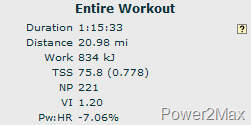
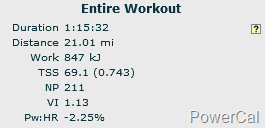
Both of these metrics were calculated online using TrainingPeaks in the same account – to eliminate any head unit discrepancies with setup of TSS/NP/IF on the unit itself (both recorded all zeros and at one-second intervals – which is how I record all test data).
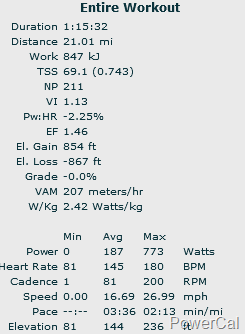
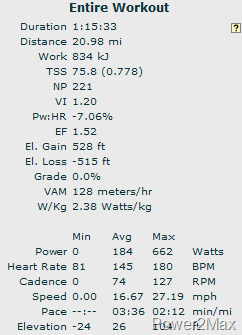
You’ll notice slight discrepancies in other metrics as recorded by the different units, though non affecting TSS/NP/IF.
8) Indoors Riding (Trainers)
I tend to do about 80% of my workouts indoors on a trainer. Both because you generally get higher quality workouts on a trainer (it’s relentless), and because it’s sometimes just easier living in a city (you get more bang for your training buck).
In doing so, it’s interesting looking at some of the numbers related to the PowerCal. These workouts were part of larger trainer accuracy tests I was doing, so it made it simple to grab the numbers for the PowerCal.
You’ll see some of the first portion of the structure within the workout I was doing, though I didn’t detail it all out as much of it was repetition. Ultimately though, the numbers speak for themselves.
Note that as is the case in all of my power meter accuracy tests – the power meters are calibrated (where applicable) at the 10-minute marker, just after the warm-up watts. The labels on the left-side correspond to chunks of the workout. For example ‘Warm-up Watts’ is a 10 minute section, ‘Calibrate Watts’ is a 2 minute section where I don’t stop anything recording, but do complete calibration.
Trainer Workout #1:
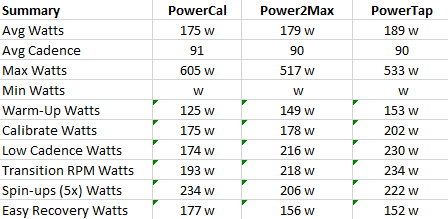
Trainer Workout #2:
This was part of a interval workout of sorts I did. Again, you see that the overall numbers are fairly close. Each interval was 60 seconds long, and each rest the same. You’ll notice that the PowerCal overestimates the rest interval by quite a bit – likely because my heart rate was rather high. Whereas the other power meter instantly recognized the lack of wattage. All my rest intervals though are still pedaling. There aren’t any stoppage points here.
I picked a few random intervals to show in the table below (as opposed to painstakingly doing the Excel math for all of them). The intervals were not at a set wattage per a CompuTrainer (or similar), but rather in a rough range, hence why they vary interval to interval.
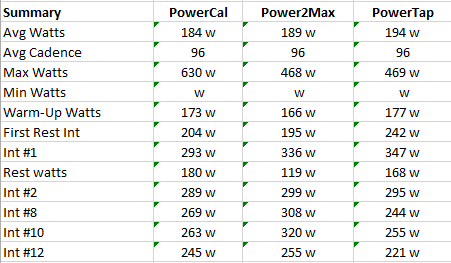
Overall, I see week after week pretty impressive results when it comes to trainer accuracy of the PowerCal. It is interesting in the above workout to see what appears to be some drift in the older version of the Power2Max.
9) Coasting/Descents and the results
Perhaps one of the more fascinating things to look at is how PowerCal handles descents – or coasting in particular. Obviously you can still descend and put out a lot of power (as I painfully learned while riding with some pros in Colorado last year).
But in general, if you’re coasting, you aren’t likely putting out much power. Often called ‘soft-pedaling’, you may be just putting out a few dozen watts, simply enough to turn the crank around slowly.
I took the below snippet from a recent ride as I descended down a hill. Let me walk you through what you’re seeing on the charts.
Brown: This is the hill, or the descending of altitude. From left to right, you see that I’m largely going downhill.
Teal Line (light blue): This line is my cadence. You’ll see it’s dropping often down to 0 (the bottom). But generally being fairly light I’m just pedaling around 70 or so RPM – not pushing it at my usual 90-100rpm.
Blue Line: This is my heart rate. The scope of the graph makes it appear as though it’s a constant – but in reality, at least for the first portion, it goes down.
Red: Power. Simple enough, this is the PowerCal’s power output.
Now, with that background, flip to after the picture and I’ll explain what’s going on.
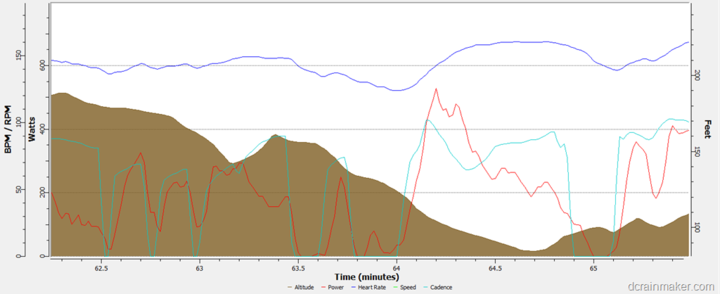
First look at the left third of the chart, and in particular, the bottom portion where the red power and cadence are displayed. Note how there’s a slight delay between when I pedal (and the value jumps from zero), to when the power is registered?
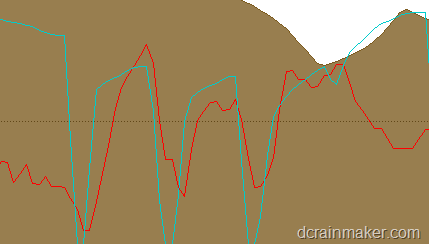
You can see it pretty clearly above – teal always leads the red. Like cat and mouse.
Now, if you look up at the heart rate, you’ll see tiny little jumps each time I start pedaling. This is logical, since for every action there’s some sort of reaction. In my case the energy exerted pedaling requires some level of heart rate (effort). Each yellow highlighted section shows the increase in heart rate, causing the increase in power displayed.

Of course, cadence as a metric isn’t taken to account by PowerCal. Rather, I’m just using it as it’s a very easy metric to show what my pedals are actually doing above.
Now the important thing here is that it’s about rate of change – not about straight heart rate. Note that as I come down in heart rate (blue) and start to flatten out, the unit realizes I must be applying more wattage. Otherwise, my heart rate have continued to decline. Then notice that as the rate of change decreases (heart rate), it means I’m applying less force – and thus less power. And therefor you see the red start to taper out.
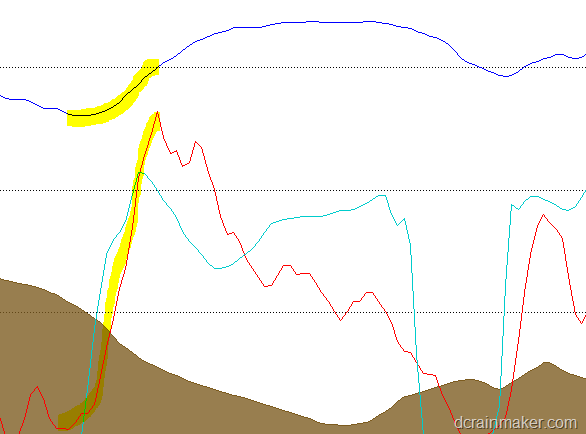
Of course, if you look at the teal line, you see this confirmed within cadence. Now, I could have simply changed gears and lowered by cadence but increased my power. But that’s not what happened.
In fact, below, taken from a PowerTap – shows a fairly similar power curve:
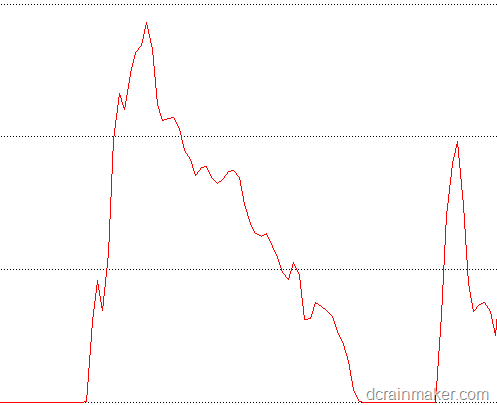
Finally, looking at stopping (when my bike stops rolling, generally not due to a crash). In the below graph, I stopped. For what I assume was a stoplight/stop sign, though it’s not clear. What is clear is that my speed went to zero for about 15 or so seconds.
Speed is shown in green. Whereas power is shown in red. You see that as you’d expect, power zeros out before speed (you stop pedaling), and then speed flat-lines. It won’t always be quite as clean and with complete zeros as this (note the tiny little red bump up in the middle of the first stop) – but it gives you a good idea of what it looks like.
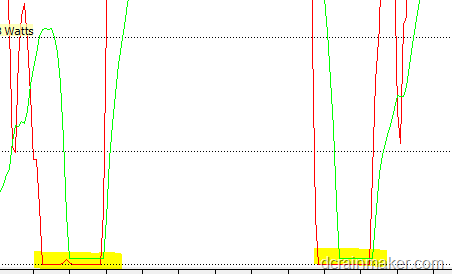
In summary, it’s not actually at all about coasting or descending – rather, it’s actually just about heart rate. More specifically, change in heart rate, and that rate of change.
10) Calibration – You can still do it.
The PowerCal calibration option was effectively removed as a requirement this past summer upon release of PowerCal. Initial pre-release information and units required/preferred a calibration test occur not only prior to use, but also every “4-8 weeks, as fitness levels change”.
However, upon release this summer, CycleOps removed the calibration requirement, noting the following (in an e-mail to the Wattage group):
“PowerCal can be calibrated but based on the study conducted at CU-Boulder there wasn’t any indication it addressed any of the expected short falls relative to accuracy so it’s not really worth the effort. Keep in mind this is terms of a sweeping recommendation across a wide population of athletes, there were instances of the calibration significantly improving accuracy across all activity types for some users. We just couldn’t find a correlation between anything specific for those that the calibration worked for and those that it did not.” – Jesse B. – CycleOps.
As noted, PowerCal can still be calibrated, but in my testing I haven’t seen any substantial differences between the initial test unit that I calibrated the first time around, versus the new unit that I have that doesn’t require calibration.
For those interested in calibration however, the test is essentially a threshold test of sorts, and the official documented procedure as as follows. However, it does require the use of a normal power meter (direct force power meter), such as a PowerTap, SRM, Quarq Cinqo, Power2Max, etc… Ultimately, you’d want to ensure that power meter is correctly calibrated.
In fact, here’s the full list of things you’ll need:
1) Power meter (direct force)
2) Heart rate strap
3) Head unit (bike computer that can record the HR and power data)
4) ANT+ USB stick (found with various Garmin devices, some PowerCal packages, or solo)
Then, you’ll go ahead and pair that power meter to a head unit (bike computer) of your choice, along with a heart rate strap. You’ll want to ensure that can be imported into the CycleOps PowerAgent software (downloadable on their site, used for analyzing workouts from CycleOps devices).
Once all that’s set, perform the following test:
Calibration Test Protocol
5 min warm up
3 min Very Easy
3 min Easy
3 min Moderate
3 min Moderately Hard
3 min Very Hard
In their initial documentation, they included the below graph as a general indicator of what you’re looking for consistency wise:
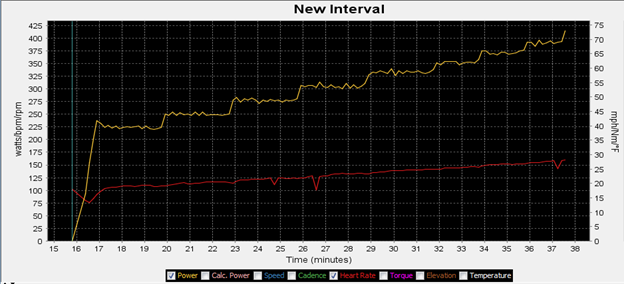
Once you’ve got the data imported into PowerAgent, you’ll want to go ahead and open the workout up in PowerAgent.
Highlight the section of the ride beginning with the warm up to the end of the fifth stage. Go to Tools > Configure PowerCal. There will be a pop-up window with the calibration highlighted. Click OK. Another pop-up window will appear confirming the new parameters. Click OK. A second pop-up window will appear asking if you would like to update the PowerCal. Make sure the ANT+ USB stick is in (you’ll need one by the way) and click OK. When finished it will confirm success.
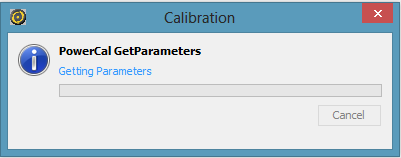
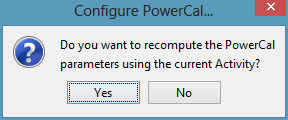
When finished and ready to workout pair the PowerCal as a Power and HR sensor and you’re ready to go.
11) Running (why not?)
Last but not least…
Like Mythbusters, I like to take this beyond the intended myth. And this is one of those cases. Many folks have pondered how PowerCal handles running – and whether there could be any value pulled from it. Of course, today there isn’t a direct equivalent to ‘wattage’ for runners. There’s no ability to correlate an effort on a hill with that on the flats. One could have two equal wattage efforts and that would clearly be seen on a bike – but far less so with running and pace.
Ultimately, PowerCal will happily provide you with wattage data for your run. In fact, PowerCal will happily provide you with wattage data anytime your heart rate is pumping. Be it running, yoga, fencing or simply having sex. If you got blood flowing, PowerCal’s there to capture it.
But correlating that data to something useful is where it becomes challenging. For example, on a treadmill workout today, beyond the first two minutes, the treadmill was set on a specific inline and speed. It never waivered. In the real world – that would mean that my output was the same. But in the PowerCal world, it instead wavered based on heart rate – which slowly climbed (mostly due to lack of cooling).
Personally, I’ve found metrics like Training Peaks Graded Pace far more valuable for measuring run to run performance across differing terrain on different days.
Now, make no mistake – wattage or an equivalent will absolutely come to running. Not this year, likely not next, but it’s out there – and there’s a number of different teams and companies working on it. Of course, just like cycling in the early wattage days, it’s going to first look like a jumble of numbers and then take years to get to the point of really being able to make the most of the data.
It’ll come though, someday.
Summary:
At this point I suspect you probably have a pretty good idea of whether or not the PowerCal is a good tool for your training needs. But, before I give you some parting thoughts, here’s a quick table of pros and cons.
Pros and Cons:
Pros:
– Cheap, really cheap
– A gateway drug to full blown power meters
– Compatible with any ANT+ power meter device, easily integrates with existing devices
– Includes ANT+ heart rate strap functionality as well (you can use that part standalone for a run, which I do all the time).
– Can be calibrated, if you want to venture down that path
Cons:
– Shorter duration accuracy is rough
– Longer duration accuracy depends on many variables
– Pace fluctuates quite a bit
– May not be as accurate for everyone, highly individualized
– Calibration procedure requires repeated testing, may not improve accuracy
Final thoughts:
PowerCal isn’t marketed as a 100% accurate power meter. Nor as a tool for elite athletes (or any advanced athlete) to use as a hard core pacing device in a race or even day to day training. Instead, what it does offer is a low-cost method of getting a rough order of magnitude of your power level on a given ride. CycleOps is rather straightforward about this, from their own site:
“The PowerCal is not as accurate as a PowerTap and not intended to replace one. Research has shown varying degrees of accuracy based on individuals and types of riding. Accuracy will depend greatly on the individual and type of riding.”
Now there are many alternatives that can estimate power information after the fact – some of them free or relatively cheap. However, most of them are just that – after the fact, and separate. If you want some sort of integrated metrics that automatically show up in whatever bike computer you’re using – there’s really only two choices: PowerCal, or a normal power meter.
Note that you shouldn’t take a PowerCal wattage number and attempt to compare it against someone else’s power meter number. There are just too many variables. It’s better for plotting progress against yourself over time.
In my mind, the perfect target audience for something like PowerCal is actually my Dad. He normally rides about 100 to 150 miles a week, but he doesn’t race (triathlon or cycling). Rather, he rides to enjoy riding and to stay fit. Today, he uses simple speed on known courses/routes to determine his improvement week over week. While there are pitfalls to this, that’s the only tool in his (and most cyclists) bag to work with. Something like the PowerCal would give him a general idea of his improvement within the season. It wouldn’t be perfect, but it would work – as seen by not only the vast majority of the data here in this review, but also many other reviews and data points out there.
But as noted, it’s not for everyone. Personally, I wouldn’t use it day to day in my training, because my training is focused and specific enough that I need to ensure my numbers are consistent and accurate from session to session and within a session at shorter intervals than the PowerCal can respond to. Though, I would point out that I do believe the vast majority of power meter users today don’t get truly accurate and consistent numbers session to session. Instead, they look at trends. Merely looking at some of the differences you can see above between the PowerTap and the Power2Max in my data is a obvious indication of that.
Ultimately, the PowerCal is just a tool. As I always note in power meter related reviews, you still have to go out there and do the hard work to get better. This is simply one more (low-cost) tool in your bag to try and capture, analyze and make improvements on your work. Good luck!
Found this review useful? Here’s how you can help support future reviews with just a single click! Read on…
Hopefully you found this review useful. At the end of the day, I’m an athlete just like you looking for the most detail possible on a new purchase – so my review is written from the standpoint of how I used the device. The reviews generally take a lot of hours to put together, so it’s a fair bit of work (and labor of love). As you probably noticed by looking below, I also take time to answer all the questions posted in the comments – and there’s quite a bit of detail in there as well.

I’ve partnered with Clever Training to offer all DC Rainmaker readers an exclusive 10% discount across the board on all products (except clearance items). You can pickup the PowerCal below. Then receive 10% off of everything in your cart by adding code DCR10BTF at checkout. By doing so, you not only support the site (and all the work I do here) – but you also get a sweet discount. And, since this item is more than $75, you get free US shipping as well.
Additionally, you can also use Amazon to purchase the unit or accessories (though, no discount on either from Amazon). Or, anything else you pickup on Amazon helps support the site as well (socks, laundry detergent, cowbells). If you’re outside the US, I’ve got links to all of the major individual country Amazon stores on the sidebar towards the top. Though, Clever Training also ships most places too and you get the 10% discount.
Thanks for reading! And as always, feel free to post comments or questions in the comments section below, I’ll be happy to try and answer them as quickly as possible. And lastly, if you felt this review was useful – I always appreciate feedback in the comments below. Thanks!
Finally, I’ve written up a ton of helpful guides around using most of the major fitness devices, which you may find useful in getting started with the devices. These guides are all listed on this page here.











